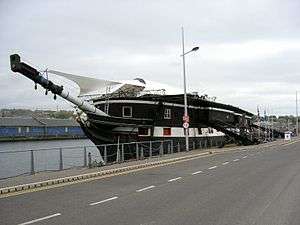Reserve fleet
_underway_c1947.jpg)

A reserve fleet is a collection of naval vessels of all types that are fully equipped for service but are not currently needed, and thus partially or fully decommissioned. A reserve fleet is informally said to be "in mothballs" or "mothballed"; an equivalent expression in unofficial modern U.S. naval usage is "ghost fleet". In earlier times, and especially in British usage, these ships were said to be laid up in ordinary.
Overview
Such ships are held in reserve against a time when it may be necessary to call them back into service, and they are usually tied up in backwater areas near naval bases or shipyards to speed the reactivation process. They may be modified, for instance by having rust-prone areas sealed off or wrapped in plastic or, in the case of sailing warships, the masts removed. While being held in the reserve fleet, ships typically have a minimal crew (known informally as a skeleton crew) to ensure that they stay in somewhat usable condition. If for nothing else, their bilge pumps need to be run regularly to reduce corrosion of their steel and to prevent the ships from foundering at their moorings.
When a ship is placed into reserve status, the various parts and weapon systems that the ship uses are also placed in a storage facility, so that if the warship is reactivated, the proper spare parts and ammunition are available, but like the ships themselves, the stored parts and equipment are prone to fall into disrepair, suffer metal corrosion, and become obsolete.
Principal reserve fleets
- The British Reserve Fleet was a repository for British decommissioned warships from c. 1800 until c. 1970.[1]
- The United States National Defense Reserve Fleet (NDRF), consists of about fifty World War II ships that have been moored in Suisun Bay near San Francisco since the 1950s or '60s.[2] The fleet includes military troopships and tankers.[2]
Alternatives
In practice most reserve ships rapidly become obsolete and are scrapped, or used for experiments or target practice, or are sold to other nations (and occasionally to private companies for civilian conversion), or become museum ships or artificial reefs.
Exporting the vessels for shipbreaking or dismantling are alternatives to reserve fleets.[3] More recently, the U.S. Navy has established a program to allow ships, such as Oriskany, to be sunk in selected locations to create artificial reefs.
Recycling is another option, as in the case of the United States National Defense Reserve Fleet (NDRF), the ships of which are set to be stripped of their paint, cut into pieces, and then recycled.[2]
Steel from pre-nuclear age ships either mothballed or sunk and raised, called low-background steel, is used in experimental physics when the experiment requires shielding material which is itself only extremely weakly radioactive, emitting less than present-day background radiation; materials which were manufactured after atmospheric nuclear explosions had taken place reflect the higher ambient level of radioactivity that fallout has caused.[4]
Environmental concerns
The practice of exporting and dismantling ships has caused international protests as they contain toxic materials.[3] In 2007, following studies that found that 20 tons of lead paint had flaked off the ships of the NDRF, environmentalist groups sued to have them removed. The federal Maritime Administration has agreed to remove more than 50 of the ships as a result, 25 of which has been removed by 2012 and the remainder will be by 2017.[2]
See also

- Aircraft boneyard
- National Defense Reserve Fleet
- Suisun Bay Reserve Fleet
- United States Navy reserve fleets
References
- ↑ "Reserve Fleet 1950". British Pathe. Retrieved 23 September 2012.
- 1 2 3 4 Wollan, Malia (March 31, 2010). "California: Good-Bye to Ghost Fleet". The New York Times. Retrieved 1 April 2010.
- 1 2 US Toxic 'ghost fleet' not wanted in the UK, Greenpeace International website (November 5, 2003) accessed at June 20, 2006
- ↑ Timothy P. Lynch (August 2007). "A Historically Significant Shield for In Vivo Measurements". Health Physics. 93 (2): S119–23. PMID 17630635. doi:10.1097/01.HP.0000259867.85459.b2.
Further reading
- Daniel Madsen. Forgotten Fleet. The Mothball Navy. U.S. Naval Institute Press. 1999.
- To Sail No More. Seven volumes. Maritime Books. United Kingdom.
- P.W. Singer and August Cole. Ghost Fleet. Mariner Books, Houghton Mifflin Harcourt. 2015.